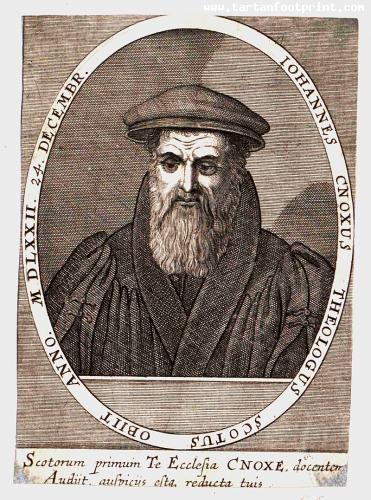You seem to be using an older version of Internet Explorer. This site requires Internet Explorer 8 or higher. Update your browser here today to fully enjoy all the marvels of this site.
July 29, 2018 by Alexander Meldrum
John Knox (1505 – 1572) – Instrumental in Protestant Reformation in Scotland.
Early life, 1505–1546
Statue of John Knox in New College Edinburgh by John Hutchison
John Knox was born sometime be...John Knox (1505 – 1572) – Instrumental in Protestant Reformation in Scotland.
Early life, 1505–1546
Statue of John Knox in New College Edinburgh by John Hutchison
John Knox was born sometime between 1505 and 1515 in or near Haddington, the county town of East Lothian. His father, William Knox, was a merchant.
All that is known of his mother is that her maiden name was Sinclair and that she died when John Knox was a child. Their eldest son, William, carried on his father's business, which helped in Knox's international communications.
Knox was probably educated at the grammar school in Haddington. In this time, the priesthood was the only path for those whose inclinations were academic rather than mercantile or agricultural.
He proceeded to further studies at the University of St Andrews or possibly at the University of Glasgow. He studied under John Major, one of the greatest scholars of the time.
Knox was ordained a Catholic priest in Edinburgh on Easter Eve of 1536 by William Chisholm, Bishop of Dunblane.
Knox first appears in public records as a priest and a notary in 1540. He was still serving in these capacities as late as 1543 when he described himself as a "minister of the sacred altar in the diocese of St.
Andrews, notary by apostolic authority" in a notarial deed dated 27 March. Rather than taking up parochial duties in a parish, he became tutor to two sons of Hugh Douglas of Longniddry.
He also taught the son of John Cockburn of Ormiston. Both of these lairds had embraced the new religious ideas of the Reformation.
John Knox was a Scottish minister, theologian, and writer who was a leader of the country's Reformation. He is the founder of the Presbyterian Church of Scotland.
Born in Giffordgate, Knox is believed to have been educated at the University of St Andrews and worked as a notary-priest. Influenced by early church reformers such as George Wishart, he joined the movement to reform the Scottish church.
He was caught up in the ecclesiastical and political events that involved the murder of Cardinal David Beaton in 1546 and the intervention of the regent of Scotland Mary of Guise, a French noblewoman. He was taken prisoner by French forces the following year and exiled to England on his release in 1549.
While in exile, Knox was licensed to work in the Church of England, where he rose in the ranks to serve King Edward VI of England as a royal chaplain.
He exerted a reforming influence on the text of the Book of Common Prayer. In England, he met and married his first wife, Margery Bowes.
When Mary Tudor ascended the throne of England and re-established Roman Catholicism, Knox was forced to resign his position and leave the country. Knox moved to Geneva and then to Frankfurt.
In Geneva, he met John Calvin, from whom he gained experience and knowledge of Reformed theology and Presbyterian polity. He created a new order of service, which was eventually adopted by the reformed church in Scotland.
He left Geneva to head the English refugee church in Frankfurt but he was forced to leave over differences concerning the liturgy, thus ending his association with the Church of England.
On his return to Scotland, Knox led the Protestant Reformation in Scotland, in partnership with the Scottish Protestant nobility.
The movement may be seen as a revolution, since it led to the ousting of Mary of Guise, who governed the country in the name of her young daughter Mary, Queen of Scots.
Knox helped write the new confession of faith and the ecclesiastical order for the newly created reformed church, the Kirk. He continued to serve as the religious leader of the Protestants throughout Mary's reign.
In several interviews with the Queen, Knox admonished her for supporting Catholic practices. When she was imprisoned for her alleged role in the murder of her husband Lord Darnley and King James VI was enthroned in her stead, Knox openly called for her execution. He continued to preach until his final days.
For full History go to Wikipedia.
In this photo:


